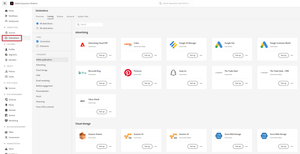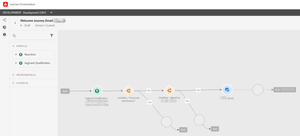
Activation in AEP
29 Jan 2023 » Platform
I am returning to my series of posts on Adobe Experience Platform (AEP), which I left a few months ago. We are at the last step, although it will take me a few posts to get into all the details I want to explain. The activation part of AEP is when we finally see the value of AEP, when we are finally using its results in our marketing efforts.
Final step
If we go back to the anatomy of an AEP project, we are at the end of it:
- The requirements have been gathered and you are working on the technical part of the project, after the U-turn.
- You have an identity strategy.
- The data sources have been identified, ETLs developed and data is ready to flow into AEP.
- Your XDM schemas and the corresponding datasets have been designed and AEP has been configured accordingly.
- These schemas and datasets have been enabled for profile after you have spent a few sleepless nights checking that you can take this step.
- Segments have been created and they are showing the expected population.
It is now time to do something with these segments, it is time to activate them.
Let me spend a few seconds with the word “activation”. The first time I heard it in this context I did not understand it. It is part of the digital marketing jargon, which means that if you are working in this area, you know what it means, but if you are not, you think it is some kind of magic ritual.
The reality is that the concept is very simple: it means taking the segments you have created somewhere and using them to send marketing messages to your customers. These can be of any type: emails, SMS, display ads, social ads… The main feature of marketing messages is that they should be as personalized as possible, as it has been proven that they perform better than very generic messaging.
You have to remember that a CDP without activation is just a very expensive and useless tool. No matter how cool it is the project to ingest the data or model in XDM, having profiles for fun makes no sense.
Activation channels
So, with this in mind, where can I send the segments from AEP to?
RTCDP
This is the most common activation type. In summary, RTCDP is about sending the audience somewhere outside of AEP, either through API calls or files. If you have worked with Adobe Audience Manager (AAM), you will notice that RTCDP is the natural evolution of a DMP. The concept is the same, just with more data to play with when creating segments.
The following is a screenshot of some of the destinations supported by AEP.
Adobe is actively working on adding new destinations, so do not be surprised if the previous screenshot seems outdated by the time you read it. Some of them are even new to me!
One interesting feature is that, if an activation channel is not currently supported, you still have the option to connect to it. You can export the audience into a file in any of the network storage types supported and send it to that destination or use the generic HTTP API destination. Another useful feature is that you are not limited to just sending the identity, but you can send additional profile attributes: first name, last name, loyalty card number…
Adobe Target
Following the same logic I mentioned in RTCDP, if it is an evolution of AAM, it should also follow that Adobe Target can use its segments seamlessly. There are two integration options between AEP and Target, depending on the JavaScript library that you use:
- at.js. If you use this library, you need to use the legacy integration between AEP and AAM, so that Target can read segments from AAM. Even if you do not have an AAM license, you still have shared audiences, which is based on AAM. It does not show up in the list of destinations; to enable it, you will need to open a ticket or request it from your Adobe representative. I have never used it directly, but I have been told that it is not completely real-time.
- WebSDK. This library makes calls to the AEP edge network, which means that AEP has the opportunity to play with the calls. The edge network can evaluate some types of segments and it can make calls to the Adobe Target Delivery API in real time. Check the help for more details on how to set it up: Adobe Target connection.
Adobe Journey Optimizer
Adobe Journey Optimizer (AJO) is one of the app services built on top of AEP. This means that it is directly connected to the guts of AEP and shares part of the technology. If you are in an older SKU, you may see Journey Orchestration, which does not have send capabilities but has the same UI and journey capabilities as AJO. The next screenshot is from JO:
We tend to simplify AJO and think of it as a tool to send spam mass emails, but it is more than that. AJO is a marketing automation tool, just like Adobe Campaign. With it, you can configure customer journeys, which will receive different messages depending on the step of the journey they are in. And it is not only for emails, as it also supports SMS and push notifications.
There are multiple places where you can see how AJO is part of AEP:
- Event-triggered journeys. You can configure a journey to start when an Experience Event with certain attributes is received by an AEP data source.
- Segment-triggered journeys. Another way to start a journey is to qualify for an AEP segment.
- In-journey segment evaluation. Once a profile is in a journey, triggered by any of the previous options, you can also add an activity to check if the profile qualifies for a segment.
- Profile update. AJO can update an AEP profile in a journey. Keep this capability in mind, as it can be very useful.
- Message personalization. The messages that are sent through any of the channels supported by AJO can include parameters from the AEP profile. It must be noted that there are some limitations when using complex data structures.
Offer Decisioning Engine
Although the Offer Decisioning Engine (ODE) tends to be part of AJO, I wanted to keep it separate and consider it its own app service. You can even use ODE in Adobe Target if WebSDK is used, which makes it even more independent from AJO in my mind.
You can see ODE as a set of offers and decisioning engine based on the following parameters:
- Placement. This is the location where the offer will be placed. This can be a piece of text or an image on a web page, a personalization section in an email, a view in a mobile application…
- Content type. Offers can be HTML, images, JSON, or plain text. Depending on the placement, one content type or another will be used.
- Constraints. These are no more, no less than segments. You can use existing AEP segments or create ad-hoc conditions.
- Ranking. For a particular placement, there could be multiple offers. If, after applying the previous rules, multiple offers still qualify, they are sorted based on this priority.
Finally, offers are grouped into collections. What you really request from ODE is the best offer in a collection and ODE will return one or many based on the four previous parameters applied to the offers in the collection.

